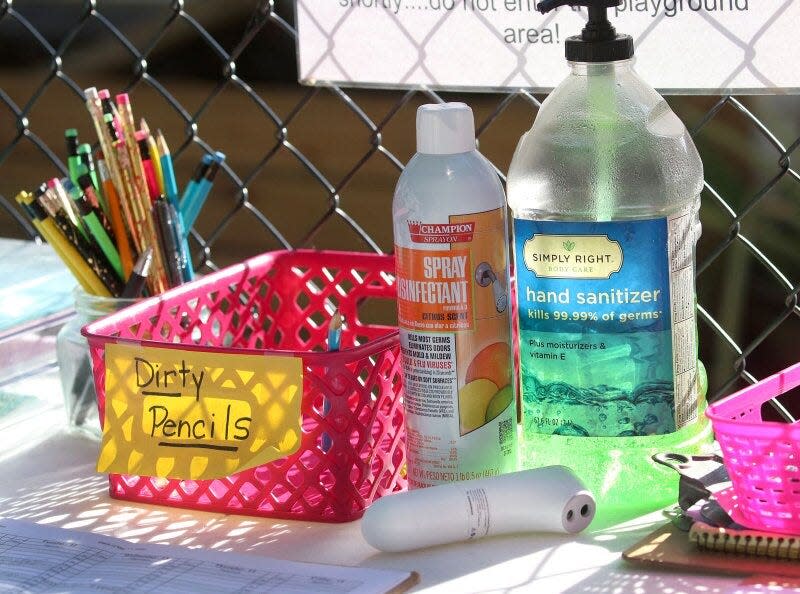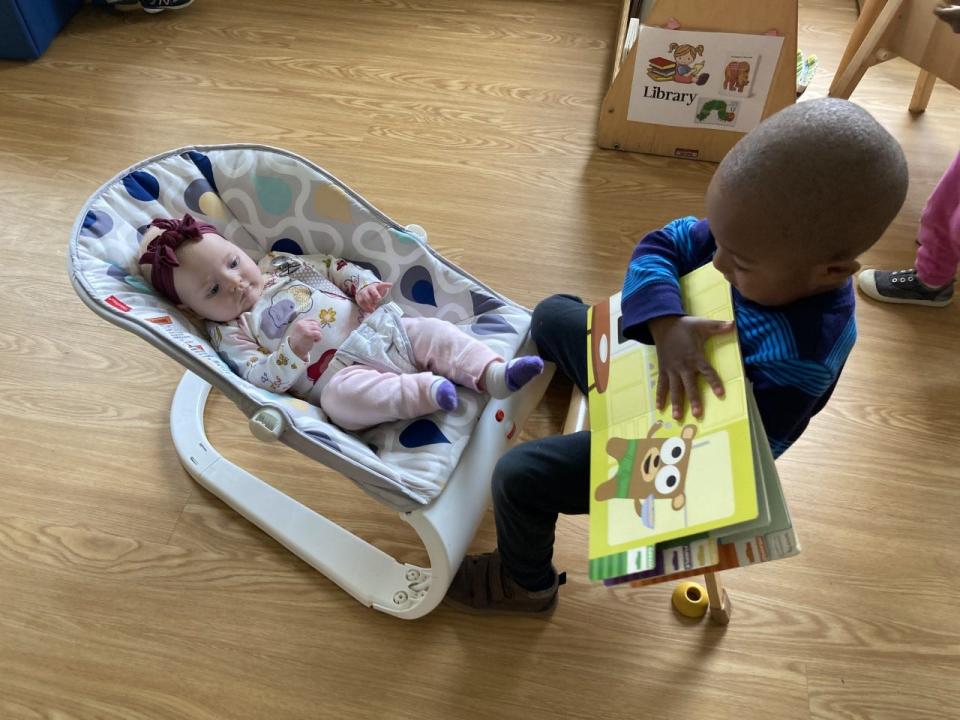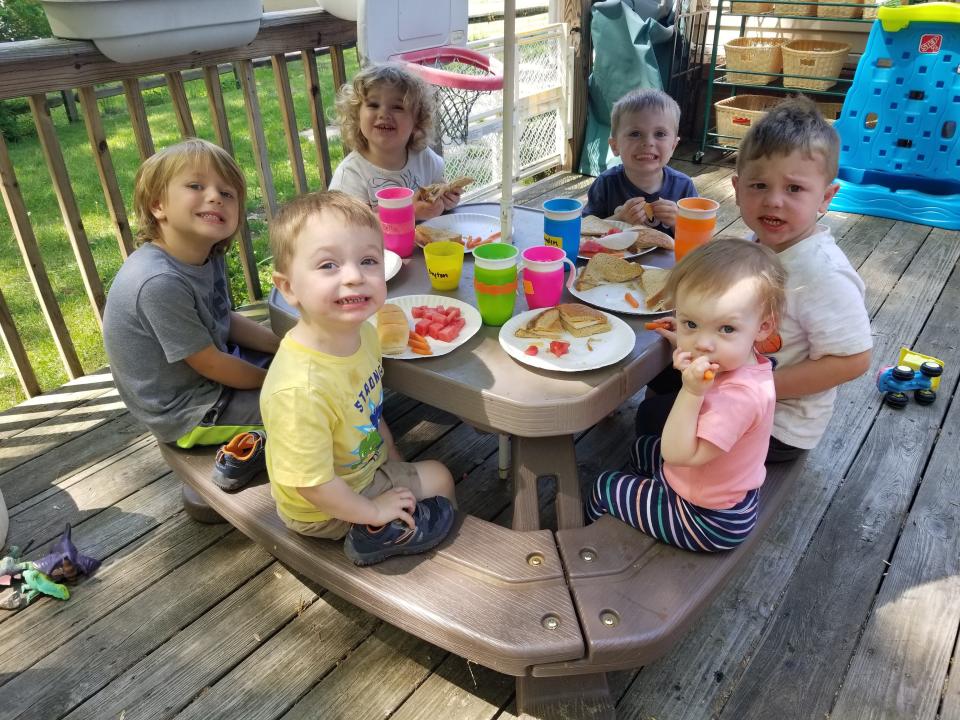Parents desperately need child care. But day cares are struggling to retain workers.
Like millions of women across the country, Shekira Bradwell found herself in a no-win situation last year.
Bradwell, a Philadelphia-area mother, realized she could either return to work and pay for a babysitter, or abandon that job and care for her child, whose school had reverted to distance learning. Bradwell’s daughter, 8, has special needs. The care her child required wasn’t just expensive, it was all but impossible to find.
Bradwell had little choice but to take family leave, a benefit that expired before her daughter’s in-person schooling resumed. By the end of the year, Bradwell, a 44-year-old with a master’s degree, found herself unemployed.

Bradwell is desperate to get back on track professionally, but she’s wary of returning to the same job she held before COVID-19 working in a child care center. The irony is, the industry’s low pay and rigorous time demands make it difficult for its workforce to meet their own child care needs.
Close to 3 million women left the U.S. labor force during the pandemic. And that trend is reflected in the 94% female child care industry, where a little more than half of the workers are mothers. According to some estimates, child care lost 1 in 6 of its jobs while COVID-19 raged.
Many of those workers may never return to those jobs, in some cases because they’ve been lured to higher-paying – if less gratifying – work elsewhere. Experts told USA TODAY of former child care providers who now work at Starbucks or McDonald’s because now they at least have health insurance. (Child care centers, which are often strapped for cash themselves, are seldom able to provide such perks.) Some workers also decided to go on unemployment, the checks more lucrative than their pay stubs.
Just half of the child care workers who left early on in the pandemic have returned, said Myra Jones-Taylor, the chief policy officer at the nonprofit Zero to Three, at a recent U.S. Senate committee hearing.
“We’re in a staffing crisis in this industry,” said Leslie Spina, the executive director of an early-childhood education provider in Philadelphia. “Workforce development is really in an ugly place right now.”
And that's a problem for the U.S. economy. Nearly 1 in 4 parents is either not working or is working less than before the pandemic, thanks to disruptions in child care and in-person school, according to a recent report by the Federal Reserve. Child care shortages continue to plague parts of the country.
For America to get back to work, it needs to solve those shortages.
Turnover was a problem before the pandemic
The hemorrhaging comes as no surprise given the hard realities of working in this industry. Child care workers earned a median hourly wage of just $11.65 in 2019, according to the Bureau of Labor Statistics.
In fact, child care workers’ low wages mean close to 2 in 5 of them live below 200% of the federal poverty level, which this year comes out to an annual salary of less than $25,760 for a single person. Thirty percent of child care workers qualify for some sort of employment assistance, said Nonie Lesaux, a Harvard professor who co-directs the school's Saul Zaentz Early Education Initiative.
Day care employees also often lack benefits, and their work is intense, both physically and emotionally. Scheduled breaks are rare; many workers can't even use the bathroom at will.
“There are some vicious cycles happening,” Lesaux said. “If I’m stressed about money, I’m going to be stressed with the kids. And it just makes the job harder.”
High turnover rates – between 26% and 40% nationally – dogged the child care industry before the pandemic hit, various studies show.
The revolving door picked up speed with the pandemic, which forced some 20,000 child care centers to shut down at least temporarily. Those that have reopened have struggled to recuperate their staff.
The reasons include anxiety about COVID-19, family and personal responsibilities and low pay. “After COVID hit, (early-childhood) teachers ... had an opportunity to reflect on how much they’re undervalued,” said Lieny Jeon, a professor at Johns Hopkins University whose research focuses on early childhood education and the child care workforce. The public perception, she said, is often: “They’re just babysitters instead of educators.”

Some of the turnover has been inevitable. Deborah Cormier, 73, had to temporarily leave her job as a front-office greeter and administrative assistant at a Kinder Academy site in Philadelphia because of health conditions – not to mention her age – that put her at greater risk of COVID-19-related complications. Her daughter, Spina, is the executive director and made the hard decision of ordering Cormier and most other at-risk employees to work from home for the time being.
“It’s very hard,” said Cormier, who's vaccinated but hasn't yet returned. “I miss being around people and especially the children.” All she wants is to play with them.
Spina said her centers – like many throughout the country – have always relied heavily on older women because they’re so reliable, committed and in tune with the community’s needs. They also serve as mentors to the younger staff. But the pandemic has made it hard for the industry to bring those workers back to centers.

“I made a decision that it was not safe to have people over 65 here,” Spina said, noting she hopes to bring them back in the fall. “I did not want to contribute to people getting sick.”
But other former child care workers say the pandemic simply underscored long-existing job challenges.
Bradwell says she was born to be an educator. After various gigs teaching college courses and Bible study, she came to a revelation. “I did not like adults,” she said half-jokingly. “I learned that my thing has always been kids.”
Despite the endless potential she enjoyed with her master's in business administration, “I wanted to go where I was needed,” said Bradwell, who recently self-published a children’s book.
Bradwell alleges she lost her job because her former employer refused to accommodate her own child care needs. Having operated remotely for the first few months of the pandemic, her workplace decided to reopen its doors in August, requiring all of its employees to return. Yet neither her daughter’s school nor her own child care had resumed in-person services. She took leave for a few months and when that ended, she had to resign.
“They made this big decision that put a strain not just on me but a lot of my colleagues as well,” Bradwell says. “It just had a snowball effect. … Child care was obsolete for me: Tell me what day care takes 8-year-olds?”
But her adverse job conditions predated the pandemic, she said. All the employees who were hired over the year and a half she worked at the center have left.
“Here I am, making sure everybody else's kid is OK, and yet my job is not going to make sure I'm OK,” Bradwell said. “It was heartbreaking for me, because I tried.”
'I don't know if I can do it'

Emily Rodenbeck, 31, tried, too. Rodenbeck even went to college to get degrees in early-childhood education.
“Caregiving – that was what I was born to do,” she said. “I loved being able to provide that to other families.”
A few years ago, she established a licensed day care in her home in southeast Michigan. Families flocked to her center, which served infants to 12-year-olds.

In 2019, she had to abandon the job to take care of her ill father. Then, in February of last year, she had her third child.
Now, despite the demand for the child care services she once provided – and despite receiving several job offers at other preschools – Rodenbeck is unsure whether she’ll go back to doing what she once did.
Much of Rodenbeck’s wariness has to do with the lack of flexibility. When running her day care, she was working from 6 a.m. to 6 p.m. She didn’t have the option of taking time off because she was, for the most part, the sole employee. And if she were to take on a job at a center-based preschool, who would watch her baby? The salary she’d make – at most $14 an hour – would hardly cover her own child care costs. Then there are the health concerns: The pandemic underscored for Rodenbeck just how much of a health risk running a home-based day care poses to her own family.
"When I think about going back to work, I don’t know if I can do it,” Rodenbeck said. Her family now lives paycheck to paycheck, but the financial incentives of resuming her work may not be worth the stress. After all, even when she was running the day care, she barely eked out a profit.
The consequences for kids
The workforce issues are compounded by a broader supply-and-demand predicament. Even before the pandemic, scores of young children lacked access to care simply because of where they lived. As of 2018, a little more than half of Americans lived in areas without sufficient options for child care, according to research by the Center for American Progress, a left-leaning think tank. Given the widespread closures – not to mention the turnover – access issues are likely to worsen, CAP says.
The problem has severe consequences for kids, whose early-childhood educational experiences can, some studies suggest, have a bearing on their success throughout and after their schooling.
Those consequences are most severe for Black and Latino children. A child care program's quality suffers when it struggles to recruit and retain trained professionals, and turnover tends to be most pronounced in low-income communities.
Better wages – and more respect – for the industry’s workers could be key to expanding children’s access to quality care.
In North Carolina, Democratic Gov. Roy Cooper has proposed an increase in the state's pre-kindergarten spending over the next two years, along with higher pay for child care workers in an attempt to create salary parity for licensed teachers in community-based centers. The lower salaries prompt many such workers to leave the centers for higher-paying jobs in elementary schools and elsewhere.
But some states are spending less this year on early-childhood education than originally budgeted, a trend that's bound to exacerbate the workforce issues.
'Our ability to sustain this work is at risk'
In late April, President Joe Biden released the details of his plan to subsidize child care for certain families and fund a national universal pre-kindergarten program.
Separately, a bill reintroduced in Congress around the same time– the Child Care for Working Families Act – would subsidize the child care costs for families making less than 150% of their state’s median income. Such families wouldn’t have to pay more than 7% of their incomes on child care; the lowest-income parents wouldn’t have to pay anything at all.
The bill, notably, would also ensure all child care workers be paid the same as elementary-school teachers with similar credentials.
Yet experts worry increasing the number of preschool opportunities may not necessarily mean an improvement in the quality. For one thing, the country may lack enough trained child care workers.
And for Jeon, of Johns Hopkins, ensuring livable wages for child care workers isn’t enough. Such efforts have to be accompanied by guaranteed benefits and opportunities for promotions, she argues.
“I’m very optimistic that, culturally, we're starting to recognize the importance of child care,” Jeon said. “But it’s much more complicated than wages.”
“We heard a lot about how people now understand how important this industry is,” said Spina, of Kinder Academy. “I hope that's not a moment in time and that we remember that the investment here leads to really good outcomes for children and families.
“Child care won't go away, but quality child care is really precarious. Our ability to sustain this work is at risk.”
Contact Alia Wong at (202) 507-2256 or awong@usatoday.com. Follow her on Twitter at @aliaemily.
Early childhood education coverage at USA TODAY is made possible in part by a grant from Save the Children. Save the Children does not provide editorial input.
This article originally appeared on USA TODAY: Daycare nearby is hard to find as child care centers can't fill jobs

